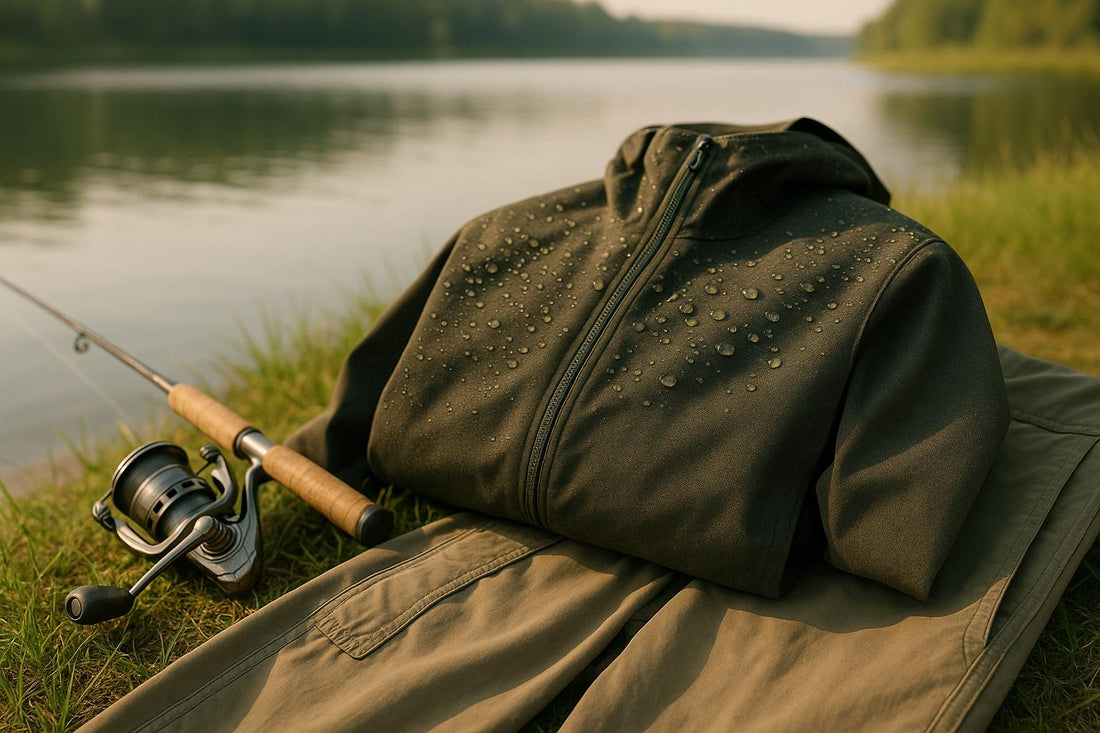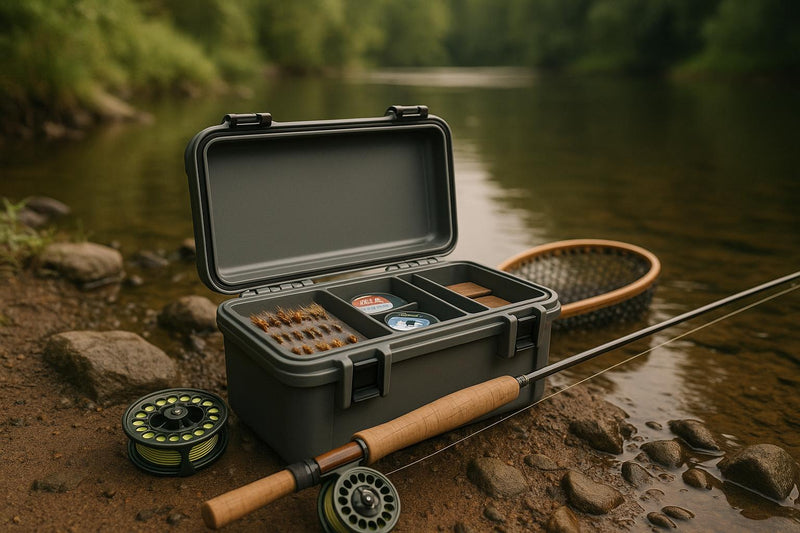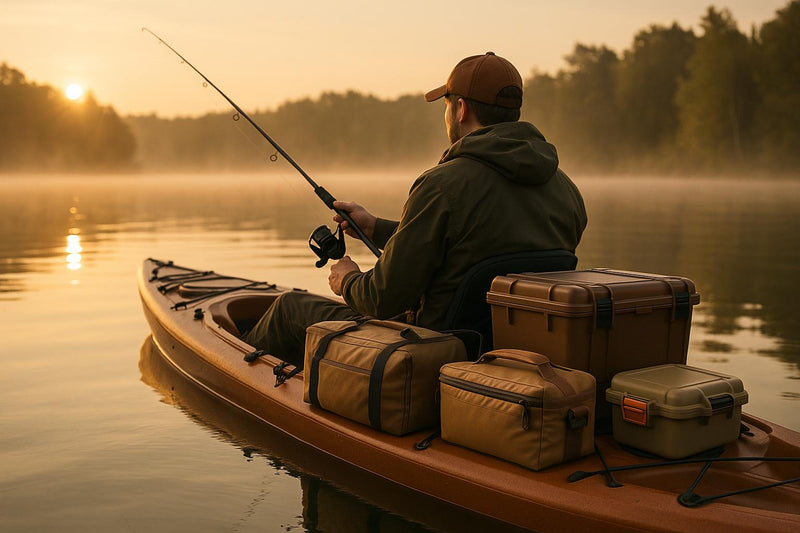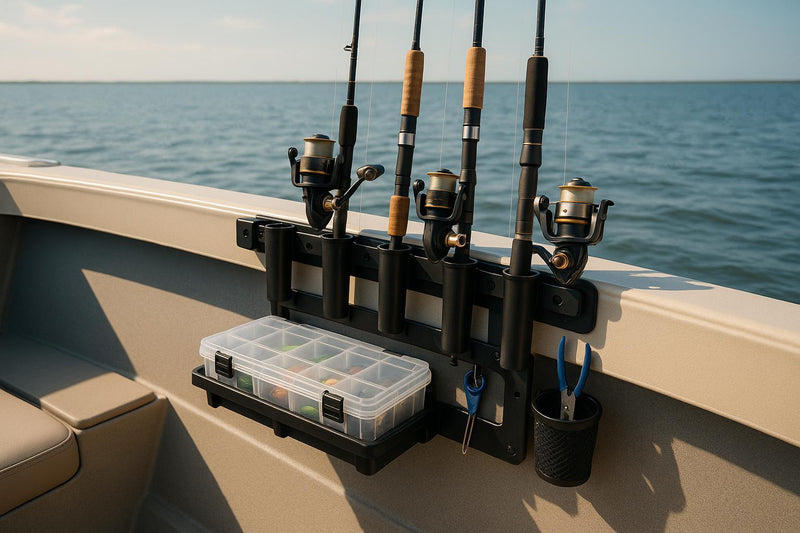When fishing, staying dry and comfortable is crucial. Two main technologies help with this: water-resistant coatings and quick-dry fabrics. Here's how they differ:
- Water-resistant coatings repel water, keeping you dry during light rain or splashes. However, they can feel less breathable and require maintenance over time.
- Quick-dry fabrics wick moisture away and dry fast, making them ideal for hot, humid conditions. They don't block water but are lightweight and easy to care for.
Key takeaway: Use water-resistant coatings for wet conditions and quick-dry fabrics for heat and sweat. For maximum comfort, hybrid gear combines both.
Quick Comparison
| Feature | Water-Resistant Coatings | Quick-Dry Fabrics |
|---|---|---|
| Function | Blocks water | Wicks and dries moisture |
| Breathability | Limited | Excellent |
| Best Use | Rainy or wet conditions | Hot, humid environments |
| Maintenance | Requires reapplication | Easy to care for |
| Weight | Heavier | Lightweight |
For versatile fishing gear that blends these technologies, check out options combining water resistance with quick-dry materials.
What Are Water-Resistant Coatings
For anglers, staying dry is essential when facing unpredictable weather and water conditions. Water-resistant coatings play a key role by repelling moisture and creating a protective barrier on fabric surfaces. These treatments help fend off morning dew, light rain, or the occasional splash by causing water to bead up and roll off rather than soaking into the material.
One of the most popular treatments is Durable Water Repellent (DWR). This technology transforms regular fabric into a moisture-resistant surface, making it a standard feature in high-quality fishing shorts like Reel Comfort’s men's fishing shorts. Let’s dive into how these coatings work and why they’re so effective.
How Water-Resistant Coatings Work
DWR coatings work by altering the surface tension of the fabric. They create a microscopic layer that changes how water interacts with the material’s fibers. Instead of soaking in, water forms tight droplets that slide off easily. This process not only keeps moisture out but also allows air to circulate, maintaining breathability.
The effectiveness of these coatings depends on two factors: the quality of the DWR treatment and the fabric’s weave. A tighter weave combined with a reliable DWR finish offers better protection against water.
Types of Water Protection
When choosing fishing gear, it’s important to understand the different levels of water protection. Here’s a quick breakdown:
- Water-resistant: Provides basic defense against moisture, suitable for light rain or brief splashes.
- Water-repellent: Uses hydrophobic technology to actively repel water, ideal for moderate rain and heavy splashing.
- Waterproof: Offers the highest level of protection, creating a near-impermeable barrier. However, no coating can guarantee complete water resistance in all conditions.
For a more precise measure, the Ingress Protection (IP) rating system comes into play. For instance, an IPx4 rating ensures splashproof protection, while IPx5 can handle water jets, making it suitable for a variety of fishing scenarios.
Care and Longevity
Over time, water-resistant coatings can lose their effectiveness due to wear and washing. If you notice water no longer beading on your gear, it’s time to reapply the treatment.
The outdoor industry is shifting away from traditional C6 DWR finishes, which contain perfluorinated chemicals (PFCs), to more environmentally friendly C0 DWR technology. While C0 treatments are better for the planet, they may require more frequent reapplication.
To extend the life of your water-resistant gear, follow these care tips:
- Wash separately using technical detergents.
- Tumble dry on low heat to reactivate the coating.
- Avoid using fabric softeners or bleach, as these can degrade the treatment.
Proper maintenance ensures your gear stays effective, keeping you dry and comfortable during those critical moments when the fish are biting. For more tips on how water-resistant gear benefits anglers, check out our guide on how water-resistant gear protects anglers. Next, we’ll explore how these coatings compare to quick-dry fabrics.
What Are Quick-Dry Fabrics
Quick-dry fabrics offer a unique solution to moisture management, setting them apart from water-resistant materials. Instead of blocking water, these fabrics focus on quickly wicking moisture away from your skin and speeding up evaporation. For anglers spending hours on the water - especially in hot, humid conditions - this technology can be a game-changer, keeping you comfortable throughout your fishing trips.
These fabrics are typically made from synthetic fibers like polyester, nylon, or specially engineered blends. Unlike cotton, which traps moisture, these materials absorb minimal water, allowing it to evaporate much faster. This keeps you feeling dry and comfortable even when you're active.
How Quick-Dry Fabrics Work
The effectiveness of quick-dry fabrics comes down to their clever, layered design. The inner layer wicks moisture from your skin to the outer layer, where it evaporates quickly. This process ensures sweat doesn't linger or seep back into the fabric, helping your skin stay dry and reducing discomfort.
Modern quick-dry materials incorporate advanced construction techniques, such as grid patterns and three-dimensional mesh structures, to create efficient pathways for moisture transfer. Breathable weaves and loose-knit designs further enhance airflow, while honeycomb-like structures improve both breathability and moisture management.
Technologies like TOPCOOL® and COOLMAX® take these features to the next level. By combining moisture-wicking capabilities with excellent air circulation, they help regulate body temperature effectively. Plus, since these fabrics achieve their performance without relying on chemical treatments, they are a more eco-conscious choice. This efficient system of moisture transfer makes quick-dry fabrics a standout option for anglers looking for high-performance gear.
Benefits for Anglers
The advantages of quick-dry fabrics go beyond just staying dry. For anglers, these materials offer practical benefits that can significantly improve your experience on the water.
One major perk is temperature regulation. On long summer days under intense sunlight and high humidity, quick-dry fishing gear helps keep your body temperature in check by efficiently managing sweat. This is especially important when you're exposed to the elements for extended periods.
Another big win is reduced chafing. When moisture lingers on your skin, it can lead to friction and irritation, particularly in areas where your clothing or gear rubs. Quick-dry fabrics minimize this issue, allowing you to focus on reeling in your catch instead of dealing with discomfort.
These fabrics are also incredibly versatile, making them suitable for a wide range of fishing scenarios. Whether you're wading in shallow waters, sitting on a boat under the blazing sun, or dealing with unexpected splashes, quick-dry gear adapts effortlessly. They're especially useful on multi-day trips, as their fast-drying capabilities mean your gear is ready to go again in no time.
Additionally, the lightweight nature of quick-dry fabrics enhances mobility. This is crucial when you're casting, reeling, or moving around your fishing spot. And if you're curious to learn more about the science behind these fabrics, check out our detailed guide on quick-dry fabric technology explained.
With quick-dry technology, you get more than just convenience - you gain a reliable tool that keeps you comfortable, mobile, and focused on what matters most: enjoying your time on the water. Whether you're a seasoned angler or just starting out, these fabrics are a smart addition to your fishing gear.
Water-Resistant Coatings vs. Quick-Dry Fabrics: Side-by-Side Comparison
When choosing fishing gear, understanding the difference between water-resistant coatings and quick-dry fabrics can help you pick the right option for your needs. While both address moisture-related challenges, they work differently and are suited for distinct conditions.
Feature Comparison Chart
| Feature | Water-Resistant Coatings | Quick-Dry Fabrics |
|---|---|---|
| Primary Function | Blocks water from soaking through the fabric | Wicks moisture away and dries quickly |
| Breathability | Limited due to the protective barrier | Excellent airflow for better ventilation |
| Comfort in Heat | Can feel warm and less breathable | Keeps you cool with effective moisture control |
| Protection Level | High resistance to splashes and light rain | Minimal water resistance, prioritizing comfort |
| Durability | Coatings can wear off over time | Built-in performance that lasts |
| Maintenance | Requires special care and reapplication | Easy to care for; often machine washable |
| Drying Time | Slower due to the water-repellent layer | Dries in under 30 minutes |
| Weight | Heavier because of the coating | Lightweight, made from synthetic materials |
| Ideal Weather | Best for rainy or wet conditions | Perfect for hot, humid environments |
| Cost | Typically more expensive upfront | Often more budget-friendly |
For anglers seeking gear that combines the benefits of both technologies, check out Reel Comfort's premium Fishing shorts, designed to handle long days on the water with ease.
Which Technology Fits Your Fishing Style
The right choice depends on your fishing environment and personal preferences. For bass anglers spending hours under the blazing sun, quick-dry fabrics offer unbeatable breathability and moisture control, keeping you cool and comfortable. On the other hand, surf fishers and anglers who wade in water need the water-blocking capabilities of water-resistant coatings to stay dry.
Tournament anglers often favor quick-dry fabrics, as comfort is key during long days of competition. When you're focused on strategy and technique, gear that minimizes sweat buildup can make a noticeable difference.
For those who want the best of both worlds, hybrid options are the way to go. Modern Fishing shorts from Reel Comfort combine water-resistant treatments with quick-dry fabric construction, offering both protection and comfort. These versatile shorts are tailored to meet the demands of anglers in a variety of fishing environments. Explore their full range of Men's Fishing Shorts to find the perfect balance for your next adventure.
In short, quick-dry fabrics are ideal for sunny, dry conditions, while water-resistant coatings shine in wet environments. For ultimate versatility, hybrid gear provides the perfect blend of comfort and protection.
sbb-itb-cb0a783
When to Use Each Technology
Choosing the right technology for your fishing conditions can make all the difference between an enjoyable day on the water and a frustrating one. Each option has its strengths, and understanding when to rely on one over the other is key. Let’s dive into when water-resistant coatings and quick-dry fabrics shine.
Best Situations for Water-Resistant Coatings
Water-resistant coatings are your go-to for unpredictable weather or situations where staying dry is crucial. Imagine those early morning fishing trips when everything is drenched in dew, or a light rain threatens to dampen your gear - this is where these coatings excel.
If you’re fishing from a boat, water-resistant coatings protect your gear from wave spray and sudden downpours. For wading anglers, durable water-repellent (DWR) coatings are essential. They keep the fabric from soaking through, ensuring the breathable membrane underneath stays functional. Without this protection, you’d likely end up feeling damp and clammy - definitely not ideal for a long day of fishing.
To keep your DWR coating effective, maintenance is key. Reapplying the coating once or twice a year using products like Revivex by Gearaid can help restore its water-shedding properties. This ensures that even if the outer layer gets wet, the inner layers remain breathable. In saltwater environments, where salt spray and crashing waves are constant challenges, water-resistant coatings are equally important for keeping your gear dry and comfortable.
Best Situations for Quick-Dry Fabrics
Quick-dry fabrics shine in hot and humid conditions where managing sweat is more important than keeping external water at bay. When temperatures soar above 85°F and the sun is relentless, these fabrics wick moisture from your skin and promote rapid evaporation, keeping you cool and comfortable.
Whether you’re kayak fishing or wading, quick-dry materials handle body heat and perspiration efficiently, ensuring you stay dry and avoid discomfort. For multi-day fishing trips where laundry facilities are non-existent, gear that dries in under 30 minutes is a game-changer. In tropical or desert climates, the breathability of quick-dry fabrics also helps regulate your body temperature, making them indispensable for long, sun-filled days.
Getting Both Technologies in One Product
Some fishing gear combines the benefits of water-resistant coatings and quick-dry fabrics, giving you the best of both worlds. Take, for example, Reel Comfort’s premium Fishing Shorts. These shorts feature water-resistant treatments on quick-dry fabric, making them perfect for damp conditions while still drying quickly under the sun.
This hybrid approach adapts effortlessly to changing conditions. In the morning, dew and fog bead up and roll off the treated surface, keeping you dry. Later, as the sun beats down and activity levels rise, the quick-dry fabric wicks sweat away, ensuring all-day comfort.
Tournament anglers, who often face 8- to 12-hour days with rapidly shifting weather - from cool, misty mornings to scorching afternoons - particularly appreciate this dual functionality. Reel Comfort’s Men’s Fishing Shorts also include features like four-way stretch panels for better mobility, reinforced stitching for durability, and removable thigh pads for rod support. These thoughtful design elements complement the water-resistant and quick-dry technologies, making them a favorite among serious anglers.
For those who fish in a variety of conditions throughout the year, hybrid gear offers outstanding versatility by combining protection, comfort, and practical features in one package.
Conclusion
Understanding the strengths and limitations of each technology is key to selecting gear that matches your fishing conditions. Water-resistant coatings are great for repelling splashes and light rain, but their effectiveness can diminish with prolonged exposure and they need regular reapplication. On the other hand, quick-dry fabrics excel at wicking and evaporating moisture quickly, keeping you comfortable after getting wet, though they don't provide as much initial water protection.
By combining these technologies, you can get the best of both worlds. A dual approach offers immediate water repellency and quick drying, ensuring comfort whether you're dealing with dew, light rain, or unexpected splashes.
Reel Comfort's premium Fishing Shorts bring these features together seamlessly. With water-resistant treatments and quick-dry fabrics, these shorts adapt to changing conditions effortlessly. Designed with ergonomic comfort, removable thigh pads, and practical storage pockets, they’re built for long days on the water.
When the weather is unpredictable, gear that blends both technologies becomes an easy choice. Whether you're competing in a tournament or enjoying a weekend fishing trip, Reel Comfort's Men's Fishing Shorts deliver the versatility and performance you need to stay focused on reeling in your next big catch.
FAQs
How can I tell when my fishing gear needs a new water-resistant coating?
Over time, the water-resistant coating on your gear can start to wear off. This happens naturally with regular use, exposure to water, and frequent washing. A simple way to tell if it’s time to refresh the coating is by observing how water interacts with the surface. If water no longer beads up and instead soaks into the fabric, it’s a clear sign the coating has worn away. You might also notice that your gear feels heavier or takes longer to dry - these are additional clues that its water-resistant properties are fading.
To maintain peak performance, always refer to the manufacturer’s care instructions. Reapplying a water-resistant treatment periodically can help ensure your gear stays ready to handle the elements on your fishing adventures.
Are quick-dry fabrics more eco-friendly than water-resistant coatings?
Quick-dry fabrics have the potential to be a more environmentally friendly option, particularly when crafted from materials like recycled polyester or organic cotton. Many of these fabrics incorporate biodegradable coatings, which help lessen their impact on the planet.
On the other hand, conventional water-resistant coatings often depend on synthetic chemicals that don't break down naturally, raising concerns about their long-term effects on the environment. For anglers aiming to make eco-conscious choices, sustainably produced quick-dry fabrics offer a smarter alternative for reducing their ecological footprint.
Can hybrid fishing gear with water-resistant coatings and quick-dry fabrics handle all weather conditions?
Hybrid fishing gear made with water-resistant coatings and quick-dry fabrics is a go-to choice for many anglers. It’s designed to handle a mix of weather conditions - whether it’s light rain, sunny skies, or a moderate breeze. These materials help shed water and dry out fast, keeping you comfortable during typical fishing outings.
That said, when the weather takes a turn for the worse - think heavy rain, snow, or strong winds - this gear might not hold up as well. Water-resistant coatings can only handle so much moisture before they give in. For those harsher conditions, you’ll want gear with a higher waterproof rating to stay protected. But for everyday fishing trips, hybrid gear offers a great mix of comfort and practicality.




